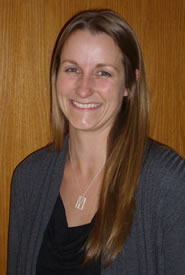Connecting with nature, people and snowshoes on Stony Mountain, Manitoba
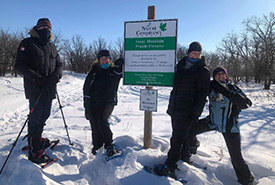
Snowshoers at Stony Mountain Prairie Preserve, MB (Photo courtesy of Julie Sveinson Pelc/NCC staff)
Winter on Manitoba’s wide open prairies is cold, windy and dark, and it seems to go on forever. It is easy to hibernate indoors all winter, under a warm blanket by the fire, with a good book and warm drink, but I wanted this winter to be different. I wanted to spend more time outside connecting with nature.
After meeting Lindsay Somers, who specializes in wellness and community health, this past November at the Nature Conservancy of Canada Manitoba Region’s NatureTalks event, I was inspired to go outside and connect with nature with people from my community.
My husband and I live on a small rural property 1.5 kilometres from the community of Stony Mountain, Manitoba, about 10 kilometres north of Winnipeg.
The community is situated on a “Manitoba mountain” consisting of limestone and dolostone that were deposited as sediment on the floor of an ancient sea. When the last ice age retreated, prairie and escarpment habitats, also known as alvars, were left behind. The highest point on the mountain is approximately 256 metres above sea level and about 20 metres higher than the surrounding area, including the city of Winnipeg.
The Stony Mountain community is rich in varied landscapes and elevation, and it is even home to a ski hill. Scenic native prairie and woodlands, including NCC-owned prairie habitat, and naturally reclaimed limestone quarries are connected by a five-kilometre-long recreational trail network.
Related blog posts
There is a strong sense of community and pride in Stony, especially around recreation, sports and the trail. Community association volunteers have put in countless hours to fundraise and develop the recreational trail. After enjoying the recreational trail this past summer with my husband on our mountain bikes, I wanted to become involved with enhancing the visitor experience through developing interpretive information and signage.
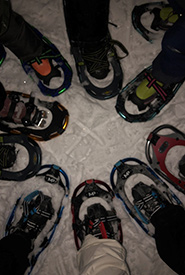
I borrowed snowshoes from work and others from the community. (Photo by Julie Sveinson Pelc/NCC staff)
I also wanted to experience the recreational trail in the winter. But how? This is where my conversation with Lindsay Somers helped. I mentioned to her that I was thinking of snowshoeing with people from the Stony community, but I didn’t really know how to get started. She suggested I pick a date, post it on Facebook, invite people and watch a YouTube video on how to snowshoe. She also suggested that I let people know that they shouldn’t worry if they didn’t know how to snowshoe and to just get outside and see what happens.
So that’s what I did. I watched a video, sent out an invite to the few people I knew in the community and borrowed snowshoes from work for myself and others from the community to connect with nature.
It worked! I set a date and was now committed. We started with four community members, armed with warm winter gear, snowshoes and headlamps, even though the moon was bright. Thursday night snowshoeing in the Stony Mountain quarry became a weekly thing for the month of January. It was a little more sporadic in February, and we were back on track for March.
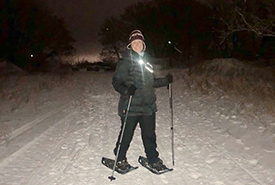
Thursday night snowshoeing in the Stony Mountain quarry became a weekly thing for the month of January. (Photo by courtesy of Julie Sveinson Pelc/NCC staff)
We typically snowshoed for about an hour on the recreational trail, with some blazing through the fresh snow in the quarry, on the frozen ponds and surrounding woodland, as well as through NCC’s prairie property. We averaged five snowshoers each week; our biggest turnout was nine people, including two kids aged three and seven.
The best part for me was connecting with new people in my community, experiencing nature and being outside in winter. Each time, a new person joined us, and we had 15 new people in total since January. Many of them had never snowshoed before, and for others it had been a long time.
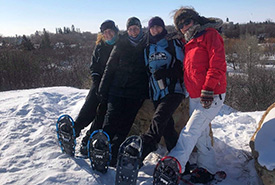
The best part for me was connecting with new people in my community, experiencing nature and being outside in winter. (Photo courtesy of Julie Sveinson Pelc/NCC staff)
Yes, the weather was extreme. It was cold, but we kept warm by being dressed for it. Being all bundled up with just our eyes showing also added some mystique to the adventure because we never really knew who was whom!
We just went out to have fun, with no judgement or expectations. It was like we were kids again playing outside with our friends, but the street lights were already on! There were a few photo shoots for Facebook documentation — to show that it really happened — and, of course, snow angels!
I did it! I found a way to connect with nature and people in the winter. We have survived the long, cold winter and are now looking forward to the coming days of snowshoeing in the warmth of the almost-spring sun.
Nature is all around us. Thank you to NCC’s Manitoba Region for providing the snowshoes so that I and my community could take time to connect with nature through play!

